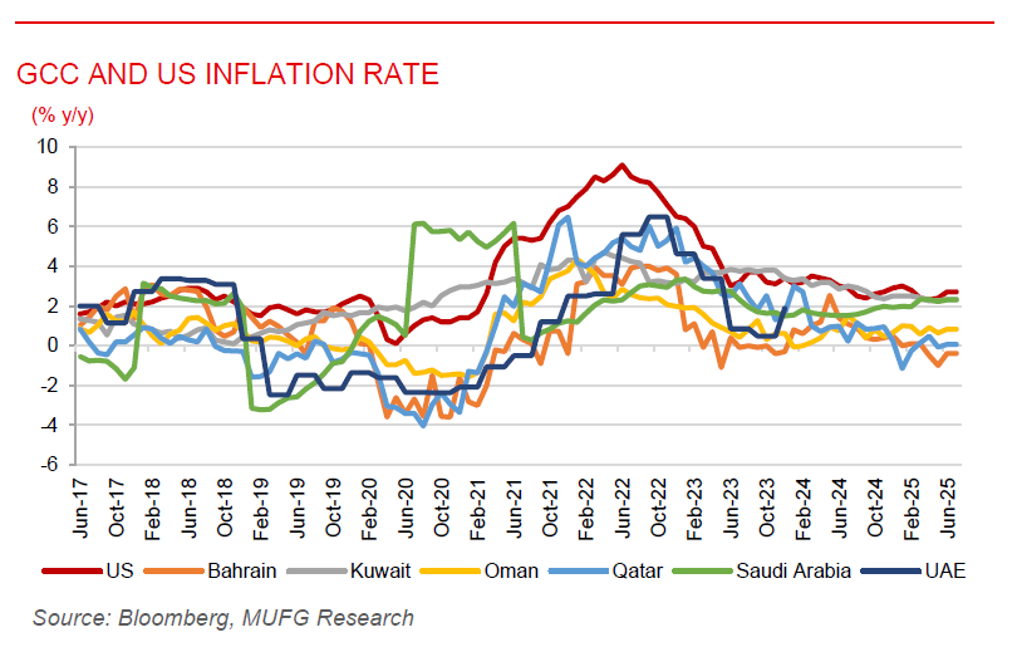To read the full report, please download the PDF above.
Middle East Daily
SOOJIN KIM
Research Analyst
DIFC Branch – Dubai
T: +44(4)387 5031
E: soojin.kim@ae.mufg.jp
MUFG Bank, Ltd. and MUFG Securities plc
A member of MUFG, a global financial group
Middle East Daily
COMMODITIES / ENERGY
Oil holds steady ahead of US-Russia summit. Oil prices remained stable as markets awaited the outcome of today’s meeting in Alaska between US President Trump and Russian President Putin, a potential turning point for global crude supply. Any change in the US’s sanctions on Russia, OPEC+’s second largest producer, could reshare trade flows disrupted by the Ukraine war, with Russia increasingly reliant on discounted sales to China and India. Last week, Trump doubled tariffs on Indian goods to 50% in response to its Russian oil purchases and is considering further curbs on the “shadow fleet” of tankers, though China remains untouched to avoid a sharp price spike. On 14 August, Trump warned of very severe consequences if Putin rejects a ceasefire, and signalled plans for a follow-up meeting with Ukraine’s Zelenskiy. Crude prices have fallen about 10% this year on weaker demand expectations linked to Trump’s trade policies and the swift return of OPEC+ supply, with forecasts for a record surplus in 2026 continuing to pressure sentiment.
Gold slips on reduced Fed rate cut bets. Gold was on track for a weekly decline, trading near USD3,335/oz, as traders scaled back expectations of a Fed rate cut next month after US wholesale inflation rose in July at the fastest pace in three years. The data pushed bond yields and the dollar higher, pressuring non-yielding bullion, while swap markets now assign a 90% probability to a September cut, down from full pricing earlier in the week. Despite gaining over 25% this year on safe haven demand gold has faced headwinds from shifting Fed policy expectations. Last week’s uncertainty over potential US tariffs on gold bars widened the future-spot market premium before narrowing when President Trump said no levy would be imposed, though formal confirmation is still pending.
MIDDLE EAST - CREDIT TRADING
End of day comment – 14 August 2025. The market appeared to be taking some risk off the table, or perhaps it was simply the first opportunity in weeks to bid on a few bonds. Still, each time a meaningful bid was hit before the data release, it raised the question of whether that might mark the day’s high. Despite recent moves in rates, most bonds remain largely indifferent, with only the more highly correlated issues marked lower, while large portions of the book stayed flat in cash and tightened by as much as 10bps. Current pricing references such as CBBT/BVAL feel largely unhelpful. In KSA, the sovereign curve tightened 5–10bps almost across the board, with the long end loosely tracking rates but still well bid, a trend also seen in ARAMCO and PIFKSA. The concern now is that prices have been bid up without much actual execution, raising the risk of a sharp sell-off that limited demand might struggle to absorb.
MIDDLE EAST - MACRO / MARKETS
July CPI trends in UAE and Saudi Arabia. In July, Dubai’s inflation picked up to 2.9% y/y from 2.4% in June, with housing and utilities remaining the main driver, surging 6.4% y/y, while transport costs posted a smaller decline of 3.4%. prices also rose in categories such as food, beverages, and education, lifting the monthly CPI by 0.4%. in Saudi Arabia, headline inflation stayed steady at 2.1% y/y from 2.3% y/y in June for the second consecutive month, the lowest in five months, supported by a 5.6% rise in housing and utilities, led by slower rent growth. Modest annual gains were recorded in food, restaurants, and education, while home furnishings, clothing, and transport saw declined. Going forward, Dubai’s inflation is likely to remain under upward pressure in the near term due to continued housing costs strength and seasonal spending trends, while Saudi Arabia’s price growth is expected to stay relatively stable, with housing remaining the key driver but offset by easing global commodity costs and contained demand in other sectors.
CBRT introduces interim inflation targets to strengthen policy credibility. The Central Bank of Turkey (CBRT) unveiled a new communication framework separating interim inflation targets from forecasts to enhance policy credibility and anchor expectations. Interim targets, set at 24% for end-2025, 16% for end-2026, and 9% for end-2027, will remain fixed barring extraordinary circumstances, while forecasts will be adjusted as needed based on incoming data. The mid-point inflation forecast for end-2025 was raised to 27% from 24%, and for end-2026 to 16% from 12%, with revisions attributed to slower disinflation, sticky services inflation, higher TRY-denominated import costs, and elevated oil prices. The CBRT maintained its tight macroprudential stance, keeping credit growth limits and TRY deposit share targets in place. On FX policy, it noted that real lira appreciation remains a likely outcome of tight policy. The updated framework is designed to guide monetary decisions, improve predictability, and strengthen commitment to disinflation, with the CBRT pledging to adjust policy proactively if inflation risks emerge within its control horizon.

